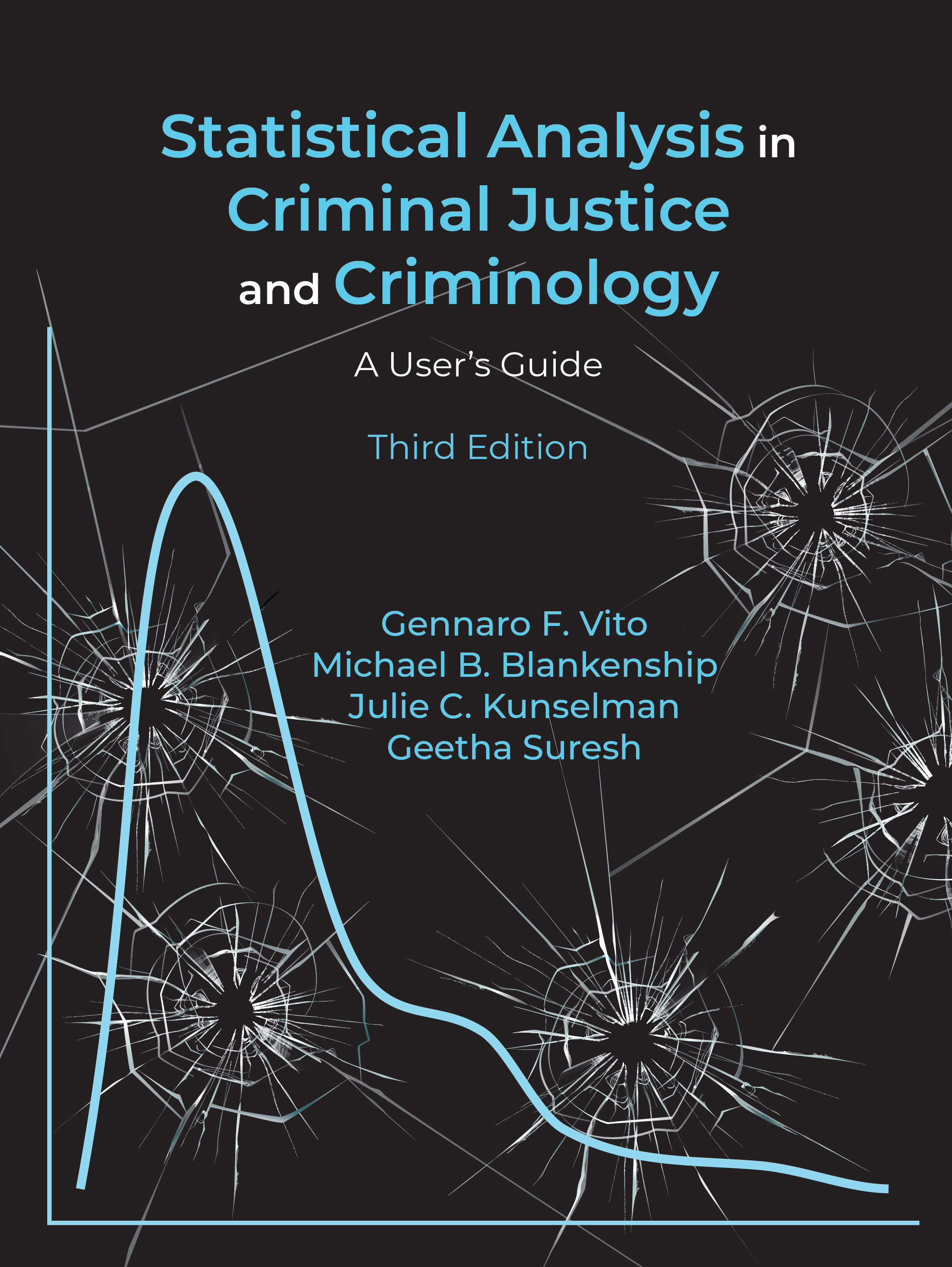“I’ve used versions of the Vito et al. text for 20 years. It is tight, straightforward, and gives my students the essentials of statistics in an understandable manner.” — Jay Coons, Sam Houston State University

259 pages, $42.95 list
1-4786-3784-6
978-1-4786-3784-4
© 2021
paperback
Student resource materials available here.
Instructor's resource materials available here
To obtain a username and password to access these materials, contact comps@waveland.com.
Instructor's resource materials available here
To obtain a username and password to access these materials, contact comps@waveland.com.
eBook availability
Statistical Analysis in Criminal Justice and Criminology
A User's Guide
Third Edition
Statistical analysis is critical in criminal justice. Professionals in the field must be diligent producers of research to assist policy makers in evaluating program and policy proposals. The key to understanding statistical analysis is by applying the concepts, methodology, and statistical procedures taught in the classroom. Written for undergraduates with little or no background in statistics, the third edition of Statistical Analysis in Criminal Justice and Criminology continues to focus on students’ understanding of fundamental analysis. It is premised on active learning utilizing common statistical tools to analyze crime data, avoiding the comprehensive approach common to many statistics texts.
Authors draw from longtime classroom experience to present complex theories in approachable ways. Exercises move from an initial step through the application of concepts explained in each chapter before insights on interpreting the results in a meaningful way is provided. New to this edition is the inclusion of both SPSS and Excel criminal justice data sets used to complete end-of-chapter exercises and analyses. This distinctive offering enables readers to develop their skills with the program most accessible to them.
Authors draw from longtime classroom experience to present complex theories in approachable ways. Exercises move from an initial step through the application of concepts explained in each chapter before insights on interpreting the results in a meaningful way is provided. New to this edition is the inclusion of both SPSS and Excel criminal justice data sets used to complete end-of-chapter exercises and analyses. This distinctive offering enables readers to develop their skills with the program most accessible to them.
Reactions
1. The Purpose of Statistical Analysis
The Validity and Reliability of Crime Statistics / Percentage Change Analysis / Lying with Statistics
2. Basic Elements of Criminal Justice Research
Elements of the Research Process / Program Evaluation / Levels of Measurement / Measurement and Types of Variables / Using SPSS: An Introduction / Using Excel: An Introduction
3. Summarizing Data and Presenting the Results
Frequency Distributions: Using SPSS / Frequency Distributions: Using Excel / Displaying Frequency Distributions Graphically Using SPSS / Displaying Frequency Distributions Graphically Using Excel / Presenting Your Results
4. Measures of Central Tendency
Measures of Central Tendency / Using SPSS to Analyze Data / Using Excel to Analyze Data
5. Measures of Dispersion
Measures of Dispersion Defined / Calculating Measures of Dispersion with SPSS / Calculating Measures of Dispersion with Excel
6. Contingency Table Analysis
Nonparametric Statistics / Constructing Contingency Tables / Chi-Square Test for Independent Samples / Measures of Association with Chi-Square / Introducing a Third Variable
7. Probability and the Normal Curve
Introduction to Probability / Probability and the Normal Curve / The Binomial Distribution / The Central Limit Theorem / Establishing Confidence Intervals
8. Difference between Means: The t-Test
The t Distribution / Hypothesis Testing
9. Analysis of Variance (One Way)
Source of ANOVA / The F Test (F Ratio) / Calculating ANOVA by Hand / One-Way ANOVA Using SPSS / ANOVA Using Excel
10. Correlation
Defining Correlation / Interpreting Correlation / Considering Causation / Calculating Pearson's r Using SPSS
11. Regression
Defining Regression
12. The Use of Statistics in Policy Analysis
The Purpose of Research / Program Evaluation / Examples of Successes and Failures
The Validity and Reliability of Crime Statistics / Percentage Change Analysis / Lying with Statistics
2. Basic Elements of Criminal Justice Research
Elements of the Research Process / Program Evaluation / Levels of Measurement / Measurement and Types of Variables / Using SPSS: An Introduction / Using Excel: An Introduction
3. Summarizing Data and Presenting the Results
Frequency Distributions: Using SPSS / Frequency Distributions: Using Excel / Displaying Frequency Distributions Graphically Using SPSS / Displaying Frequency Distributions Graphically Using Excel / Presenting Your Results
4. Measures of Central Tendency
Measures of Central Tendency / Using SPSS to Analyze Data / Using Excel to Analyze Data
5. Measures of Dispersion
Measures of Dispersion Defined / Calculating Measures of Dispersion with SPSS / Calculating Measures of Dispersion with Excel
6. Contingency Table Analysis
Nonparametric Statistics / Constructing Contingency Tables / Chi-Square Test for Independent Samples / Measures of Association with Chi-Square / Introducing a Third Variable
7. Probability and the Normal Curve
Introduction to Probability / Probability and the Normal Curve / The Binomial Distribution / The Central Limit Theorem / Establishing Confidence Intervals
8. Difference between Means: The t-Test
The t Distribution / Hypothesis Testing
9. Analysis of Variance (One Way)
Source of ANOVA / The F Test (F Ratio) / Calculating ANOVA by Hand / One-Way ANOVA Using SPSS / ANOVA Using Excel
10. Correlation
Defining Correlation / Interpreting Correlation / Considering Causation / Calculating Pearson's r Using SPSS
11. Regression
Defining Regression
12. The Use of Statistics in Policy Analysis
The Purpose of Research / Program Evaluation / Examples of Successes and Failures